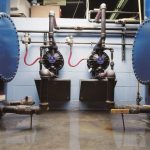Quando se trata de transferência química, a segurança é imprescindível, tanto para a proteção da integridade física dos trabalhadores, quanto para a prevenção de acidentes. Como existem inúmeros produtos químicos, desde produtos de uso doméstico, até componentes perigosos, é importante escolher a bomba ideal para esse tipo de aplicação.
Nesse sentido, as bombas pneumáticas de diafragma possuem a capacidade de lidar com uma ampla gama de produtos químicos com safety and versatility. Due to their versatility, pumps are excellent options for those looking to carry out chemical transfers safely. To help you, we have prepared some advantages that these pumps guarantee for this type of operation. Check out!
leak free construction
Leaks are always a problem, and if chemicals are involved, the problem is even greater. To avoid this, pneumatic diaphragm pumps are available in bolt-on and leak-free designs to ensure that the pumped chemical is safely contained within the pump. Also, to provide an extra layer of safety, exhaust air can be channeled to a containment location away from the workers' environment.
secure lock
Depending on the type of fluid being pumped, it may be necessary to have a safety mechanism to block the operation. Pneumatic diaphragm pumps can be blocked without causing any damage to the pump or the product. They are an excellent choice for applications that are intermittent.
It does not generate heat and does not need electricity to function.
In addition to producing no heat during operation, these pumps require no electricity to run and can be grounded for safe and reliable operation in potentially explosive atmospheres. When pumping flammable products and operating in environments with gases, this aspect is fundamental.
potential problem
Most positive displacement pumps can be damaged in some way if run dry. Pneumatic diaphragm pumps are not damaged when running dry, such as when pumping chemical tanks, unloading tanks, etc.
high chemical resistance
Because there are options for pumps in different materials, it is possible to find pneumatic diaphragm pumps compatible with different types of chemicals, so there will always be an option to meet your needs.
Support a wide range of temperatures
This equipment can withstand a wide temperature range, pumping cold fluids (consult factory when pumping sub-zero fluids) and fluids up to 104°C. For higher temperatures, consult factory for guidance.
Tip: To find chemical and temperature ratings, refer to chemical resistance guides offered by pneumatic diaphragm pump manufacturers. In these guides you can also check the pump composition materials, seals and diaphragms used.
Can handle solids and are shear sensitive
In most cases, standard ball valve units can handle solids up to ¾” (19 mm). This is especially relevant in chemical sumps, which can receive all kinds of residues that can shut down or damage other types of pumps. In addition, because they do not have rotating components, pneumatic diaphragm pumps are very sensitive to the shear of the products being pumped. This is essential for many chemicals that can be damaged if separated or cut.
are self-priming
These pumps are self-priming and do not require positive inlet pressure (NPSHA) to prime. They can pull a suction head of up to 9.8 meters, or be placed on the ground next to a tank and operate well with no inlet pressure or positive inlet pressure up to 3.0 meters. If the inlet pressure is greater than 10′, it is necessary to consult the factory for further guidance.
allowing her to handle all types of fluid
Pneumatic diaphragm pumps can be easily moved and require only a source of compressed air to operate. Some users opt for cart-mounted pumps, which ensure greater mobility and versatility for a variety of applications. A single pump can easily be used for different jobs as per the company's needs.
As a result, pneumatic pumps do not need to be permanently fixed in a single installation, and they do not require a source of electrical power. With suction/discharge hoses and an air supply, you can simply place the pump on the floor and start running. Some plants even use pneumatic pumps as a substitute for other pumping technologies while undergoing maintenance.
When it is necessary to move a pump to perform a new task, be sure to clean the pump before starting at the next location, especially if you are pumping different chemicals. Also make sure the pump is designed for all the different chemicals being pumped to avoid possible incompatibilities ( chemical compatibility). To optimize your operation, standardizing a set of materials for all pumped chemicals is essential.
Allows variable pressures and flows
Supporting flow rates up to 280 gpm (1060 lpm), pneumatic diaphragm pumps provide a wide variety of streams without the need for expensive and sophisticated controls. Pneumatic pumps and standard construction are 1:1 ratio and can produce pressures up to 125 psi (8.6 bar). High pressure pumps with a 2:1 ratio can produce pressures up to 240 psi (16.5 bar).
Can handle a wide range of viscosities
Different chemicals can have different viscosities, and it's important to have an efficient pump that can handle these chemicals. Air-operated diaphragm pumps have the ability to handle virtually any fluid and a wide range of viscosities.
Easy installation and low initial cost
No need to perform laser alignment and no need to purchase sophisticated controls to ensure efficient operation of a pneumatic pump diaphragm, just having a supply of compressed air for that. Control can be done with a valve on the fluid discharge or by controlling the air intake in the pump. As such, these pumps are the simplest and most versatile solution on the market today.
In most cases, pneumatic diaphragm pumps are considerably lower in cost compared to other positive displacement pump solutions. In addition, they do not require expensive engines, controls or the need for specialized installation.










